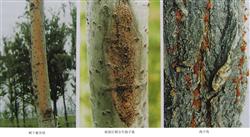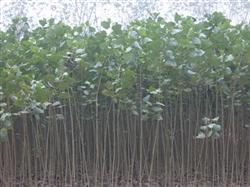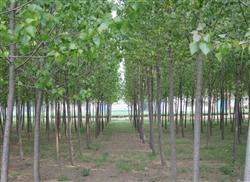Timely Control of Poplar Bacterial Canker and Rot

Poplar bacterial canker and skin rot are mainly distributed in Northeast, Northwest and North China, which are common and frequent diseases of shelterbelt, timber forest and urban and rural greening poplar in the north of China. Poplar bacterial canker and skin rot are world-famous important poplar branch diseases, but also common and frequently-occurring diseases. Its infectious bacteria widely exist in nature and can lurk on poplar trees for a long time. First, the pathogenic factors. This type of disease is in direct proportion to the degree of frost injury, sun burn, insect pest, salt injury and drought injury. Large seedlings or young trees with too large seedlings, too many transplants and false planting for too long are not easy to recover after transplantation, or when the pruning technology is poor, pruning is too strong, and mechanical injury is too much, it is beneficial to the disease. In addition, most poplar varieties in areas or years with poor environmental conditions and unfavorable cultivation measures, such as drought, waterlogging, sunburn, frost injury and other bad conditions, will occur seriously, and the disease will occur rapidly, resulting in huge losses. Second, symptoms. This type of disease harms the bark of poplar branches. From early spring to early summer, the disease produces dark brown watery spots, forming small tumor protuberances on the young branches, and some raised plaques gradually lose water, then dry up and sink, and even produce cracks. Peeling showed decay of the subcutaneous cambium and discoloration of the phloem and xylem of the tumor in the brown area on the surface of the xylem. The discoloration area cracks in summer and exudes brown mucus, which has a bad smell. In the later stage of the development of the disease, the tumor continues to form, and the wound expands and cannot heal. on the sunken skin, dense small black spots appear when rain or humidity is too high, milky white paste is extruded from the top of the black spot, and gradually turns to orange. If the disease is serious, all the way up to the branch and down to the root, the wood will change color and rot in the center, forming dead branches. Third, the law of the disease. The pathogenic bacteria overwintered in the diseased spot or diseased skin of poplar diseased plants for many years, and the pathogen began to move when it was wet and rainy in the spring of the following year (the disease began in mid-and late March in North China. The disease occurred later in Northeast China, May-June was the peak period of the disease, the disease was mild in July and stopped developing in September), and the bacterial mucus spread from the cracks. With the help of Rain Water, wind, insects, birds and human activities, the pathogen invades through poplar lenticels, leaf scars, stipule scars, bud scale scars and various wounds. The mucus produced by diseased poplar is an important source of infection. Fourth, prevention and control measures. ① strictly carries out quarantine, strictly forbids the transportation of diseased seedlings and cuttings, and disinfects suspicious seedlings and cuttings. The introduced seedlings, cuttings and other asexual reproduction materials should first be isolated and planted, and then be introduced and planted when it is proved to be disease-free. ② uses resistant varieties instead of susceptible varieties to control bacterial canker. ③ found that the diseased plants were cleared and burned in time, and ④ prevention was more important than treatment: spraying Tianlin Plant Energy mixture in early spring and late autumn + Tianda 2116 cell membrane stabilizer 600 times + Tianda organosilicon 6000 times. The diseased trees can be dried with Tianda 2116 cell membrane stabilizer 50 times solution + Tianglin plant energy mixture 50 times solution + Tianda organosilicon 100 times solution to enhance the tree potential and repair quickly.
- Prev

The method of raising Poplar seedlings in Summer
Before planting, we are prepared to select varieties with fast growth, high quality and high yield and strong adaptability, such as 80351, 72 poplar, 69 poplar and so on. From the end of July to the end of September, the cuttings began to breed when the cuttings were semi-lignified. Mass propagation is mainly based on the twigs and weak shoots of the same year's seedlings in the nursery. The width of the bed is 1 meter, the length is based on the number of cuttings, and the height is 20 centimeters. ...
- Next

Key points of cultivation techniques for fast-growing and high-yield poplar forest
In order to achieve fast growth, high yield, high quality and high efficiency of poplar, scientific cultivation techniques must be applied. According to the research results and practical experience of poplar cultivation techniques in our province, we should mainly master the following technical points: first, site selection. Selecting the forest land suitable for poplar growth is the basic rule to realize the rapid growth and high yield of poplar.
Related
- Fuxing push coffee new agricultural production and marketing class: lack of small-scale processing plants
- Jujube rice field leisure farm deep ploughing Yilan for five years to create a space for organic food and play
- Nongyu Farm-A trial of organic papaya for brave women with advanced technology
- Four points for attention in the prevention and control of diseases and insect pests of edible fungi
- How to add nutrient solution to Edible Fungi
- Is there any good way to control edible fungus mites?
- Open Inoculation Technology of Edible Fungi
- Is there any clever way to use fertilizer for edible fungus in winter?
- What agents are used to kill the pathogens of edible fungi in the mushroom shed?
- Rapid drying of Edible Fungi

